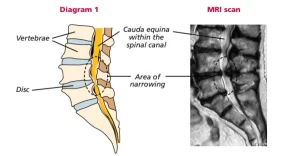Lumbar Decompression Surgery:
Easing the Traffic on Your Spinal Motorway
Lumbar decompression surgery aims to open the carriageway for smooth traffic flow along your spinal motorway (Understand Spinal Motorway). This procedure is performed under general anesthesia and typically requires a brief hospital stay. Depending on the nature and degree of compression, bone removal may be necessary to address the issue. The ultimate goal is to restore a free-flowing motorway, reducing stenosis-related symptoms.

Narrowing of the spinal canal as a result of spinal stenosis as seen in diagram 1 and MRI scan
1. The Decompression Process
- Traffic Metaphor: Think of it as easing traffic congestion on your spinal motorway.
- Procedure Details: Typically performed under general anesthesia.
- Bony Resection: Sometimes, bone removal is necessary to relieve compression.
2. Post-Operative Care
- Early Mobilization and Rehabilitation: Essential for recovery; you’ll receive guidance on physiotherapy exercises.
- Precautions: General precautions, including avoiding heavy lifting while bending forward and minimizing prolonged sitting.
- Walking After Surgery: Initially, avoid long walks in the first two weeks to prevent wound complications.
- Guided Progress: Gradually increase walking distance and activity under the supervision of your physiotherapist.
3. Recovery and Beyond
- Personalized Care: Recovery is unique to each patient; follow post-operative instructions diligently.
- Consultation: Stay in touch with your healthcare provider for monitoring and guidance.
Empower yourself with knowledge to make informed decisions regarding your health and well-being. For further guidance, assessment, and expert care, don’t hesitate to contact us today
Note: Medical conditions should always be discussed with a qualified healthcare professional. This content is for informational purposes only.
